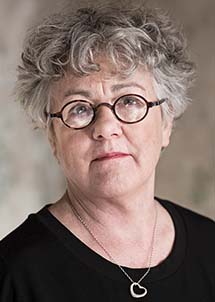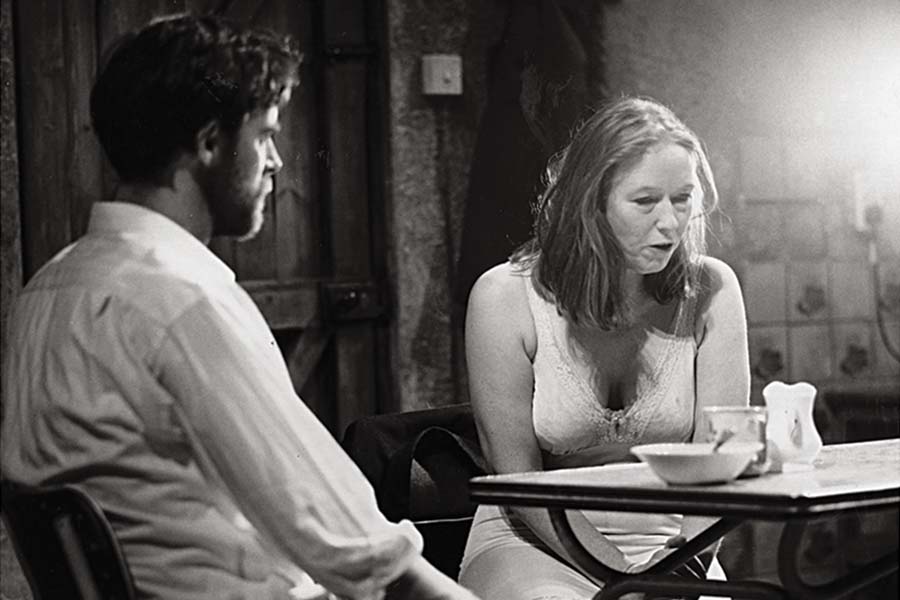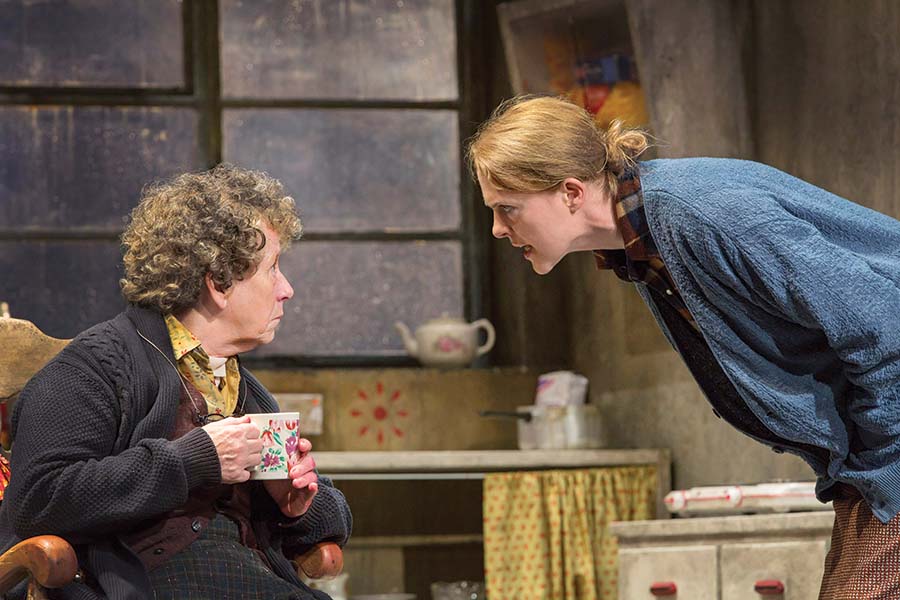“The exact fecking image of your mother you are!” exclaims Ray Dooley at Maureen Folan in the haunting final scene of Martin McDonagh’s The Beauty Queen of Leenane. Now, two decades since it presented the play’s world premiere, Druid, a theatre company in Galway, Ireland, has a new revival that makes that line seem prophetic: It features Marie Mullen, who originated the title role, portraying Maureen’s spiteful mother, Mag.

The show was a milestone for Druid. After the 1996 performances in the Emerald Isle and a stop in London, the staging came to New York City’s Atlantic Theater Company, then moved to Broadway. It took home four 1998 Tonys, including prizes for Mullen and for Garry Hynes, making her the first woman to win the award for best director of a play. Hynes, who with Mullen and actor Mick Lally founded Druid in 1975 as Ireland’s first professional theatre outside Dublin, also helms this 20th-anniversary staging of Beauty Queen. The production is currently running at the Mark Taper Forum of Los Angeles’s Center Theatre Group (Nov. 9-Dec. 18) and will travel to Brooklyn Academy of Music (Jan. 11-Feb. 5, 2017), ArtsEmerson in Boston (Feb. 8-19), the August Wilson Center in Pittsburgh (March 2-4), the Power Center at the University of Michigan in Ann Arbor (March 9-11), and Hong Kong Arts Festival (March 16-19).
A few weeks before the show went into rehearsal for its initial run at Druid’s home base, to be followed by a tour of Ireland, Hynes discussed returning to the piece all these years later.
“When the play was first performed in 1996, it was a completely new voice, a new way of looking at the Irish dramaturgy,” she explained. “Nobody had quite done what Martin had done before, so it had that massive impact because it was so new,” she said, referring to the way McDonagh turns the “obvious and familiar” into “distant and strange—and very funny.” Things have changed, Hynes noted: “Now Martin is an established writer with an established voice worldwide.”
The years have done something curious to Beauty Queen, Hynes contended. “The play is not really of the ’90s, even though it was staged in the ’90s.” It’s not the work’s newness she’s talking about: In telling the story of a lonely woman in her 40s in rural Ireland whose aging mother thwarts her attempt to find love, the play depicts “an artificial landscape of Irishness,” and uses “dramaturgical inventions that were 50-100 years old, like an intercepted letter.” These are some of the reasons, she said, that other theatres didn’t want to produce it initially. “The big challenge of the time felt like, ‘How does this play communicate with an audience in 1996?’ Now we know it does, so we won’t have that worry on our shoulders.”
Hynes was particularly excited about the possibilities of rediscovering the piece with a new cast—or, in the case of Mullen, a familiar performer in a new role. Hynes said that for years she’d been imagining a new staging with Mullen taking over for Anna Manahan, who played the part in the original production, and also won a Tony. But to have the vision is one thing; to realize it has been a process, of course. During the Galway run, Mullen, whose many credits include the theatre’s 1985 and 2014 runs of Bailegangaire by Tom Murphy (not to be confused with the actor of the same name, a Tony winner for his performance as Ray in Beauty Queen’s original production), ruminated on what it’s been like to revisit the two plays.
“Both of the actresses who did it before me, whom I admire, are still in my head to a degree,” she said. “I don’t push them out anymore,” instead allowing those portrayals—Manahan in Beauty Queen and Siobhán McKenna, whose role she took over in Bailegangaire—to inform her work early in her process, she said, then developing her own connection to the roles. Aisling O’Sullivan, the new staging’s Maureen, said she encountered a parallel pressure. “I had the shadow of Marie’s amazing performance in front of me all the time,” she said. “For me the big challenge has been to stake my own claim on the character of Maureen and to find the dramatic rules and to follow them.”
As for Mullen, coming back to Beauty Queen with Hynes led to an even richer experience because they’d cultivated a deep knowledge of the play. “When we did it 20 years ago, we had no precedent,” Mullen observed. “We knew there was something special, but maybe we didn’t know then how exactly it all worked. Whereas now, because we’ve lived with it for so long, we sort of understand what the balance is about, and how to tune it, if you like.”
As of the Galway run, that greater understanding has had an impact on the audience response. “I think they are more tuned in to the humor this time—it’s just an observation, it may not be true yet—and also the sadness of the situation between the mother and daughter is really getting them this time,” said Mullen. Though her years of collaborating with Hynes and their prior work on the piece led to a shorthand between them, “a marriage of the play and how it works,” Mullen stressed that the production is hardly a retread. “I am playing a different character, and that is a completely new world for Garry and I to work on.”

Maureen wishes to escape the world depicted in Beauty Queen—the mythic, oppressive version of western Ireland—and the idea of restarting her life in the U.S. comes up repeatedly. So it’s especially fitting for the play to journey across the Atlantic. But if traveling to the States is a source of tension in the piece, the logistics of bringing the production over posed their own unique challenges. Set and costume designer Francis O’Connor, who, as Hynes mentioned, first worked with her on the original mounting and has had a fruitful creative relationship since, commented before the show opened in L.A. that starting the tour at the Taper led to significant changes in the set.
“This venue has a deep thrust to the stage, so we can’t create the side walls so completely as we have in Ireland,” he said. “I’ve used the conduit to create and extend the skeleton of the room.” Even so, he said, the room’s layout is staying mostly the same. “This geography of the space has worked really well. We definitely wanted to maintain that throughout the entire tour.”
In fact, he and Hynes pointed out that very little of the scenery changed from 1996. For O’Connor, the most rewarding part of returning to the piece “was to discover that what we had imagined for the play 20 years ago still made sense to us.” O’Connor explained that since it was later remounted as part of Druid’s Leenane Trilogy—which included Beauty Queen alongside two other McDonagh plays set in the same County Galway village, A Skull in Connemara and The Lonesome West—“the design had frequently been tweaked and adjusted. What was useful was to reconsider the details of the space. Amongst other detail changes, the window is now wider, which helps the linear aspect of the set.”
The physical act of bringing over the set was tricky too. Danny Erskine, the production’s company manager, said that, because the U.S. tour would begin so soon after the final performance in Ireland, it wasn’t feasible to use the same set pieces, props, and costumes in both countries—typically the preferred option when taking a production on tour.
“We had to ship a sea container after the second week of rehearsals, and so the process became much more difficult,” he said. “The excellent set-building company Theatre Production Services (TPS), based in Dublin, had to make two identical sets, each of which had to then be treated by a scenic artist before the first was shipped to the U.S. and the second went on to meet us in Galway for our first performance.” In addition, Erskine said, “Every piece of furniture and prop—from large items like a stove or a rocking chair, to as small as a comb or a set of keys—had to be researched, sourced, and purchased in duplicate so that we could send one of every item along with the U.S. set. Doing a show based in Ireland also means that most elements cannot be sourced in America, especially if it is not set in the modern day. You can imagine how difficult it is to find two identical, out-of-production space heaters from secondhand and antique dealers. But it was done.”
On the performance side, the show has remained the same except for the occasional adjustment to ensure clarity for international audiences. Mag’s burnt left hand is a key element in the play, which resulted in a conversation about the pronunciation of “scald,” which in Ireland often sounds like “scowled,” Mullen explained. For the States they’ve modified it to the more familiar American pronunciation, to rhyme with “bawled.”
Mullen found that the show resonated strongly with U.S. audiences in 1998, “once they were able to understand, or got tuned in to our accent,” and said she suspects the same would be true this time. “The basic thing is making sure you’re understood and heard, and after that the audiences can deal with it themselves,” she said. “Once they know where you’re coming from and they can hear what you’re saying, they have the power to make their own mind up about the piece.”
*An earlier version of this story incorrectly referred to Tom Murphy the playwright and Tom Murphy the performer as the same person.


